.gif) |
The Solar Eclipse
of January 4, 2011
Communiqué
See also below the pictures of the eclipse from Constantine
as well as from Marrakech in Morocco to Oman
- The "Adab" of watching an eclipse in Islam
by Usama Hasan
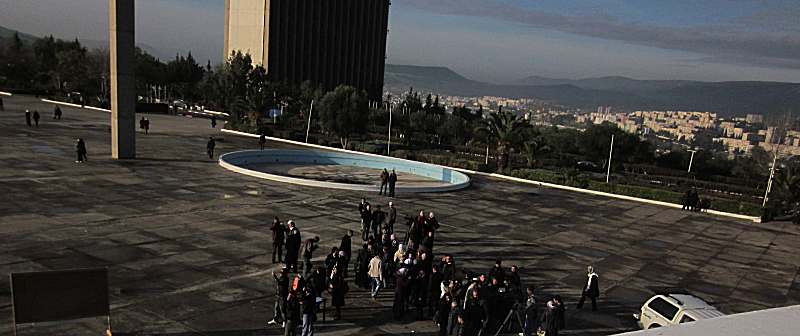 |
An observation site was set up on the central plaza of Mentouri University for the benefit of the students. The national TV team was with us (See the pick up at right). And in fact we provided them with the filter which enabled the eclipse sequence to be shown on national news from Constantine that day! |
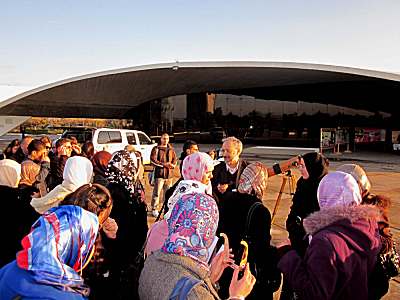
Rising sun. Already a crowd is there while the Sun's disk is already bitten by the Moon. |
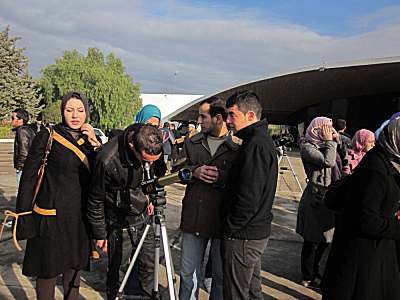
Using the PST solar telescope |
 |
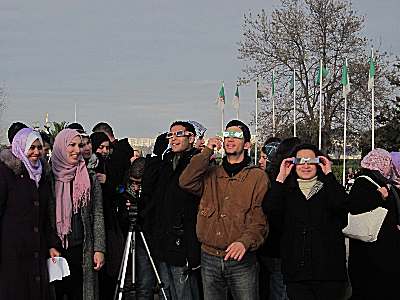
Enjoying... |
Communiqué
Eclipse Solaire Partielle
ce Mardi 4 Janvier 2011
(Le texte du communiqué se trouve à http://siriusalgeria.net/eclipse2011)
Nous serons gratifié ce Mardi 4 Janvier 2011 d’un événement céleste remarquable largement observable d’Algérie ; il s’agit d’une éclipse solaire partielle qui se déroulera dès le lever du jour. Comme toute éclipse solaire, elle ne pourra être observée directement à l’œil nu vu que la partie non éclipsée du disque solaire est à même de provoquer des lésions rétiniennes graves. Seule une observation à l’aide d’instruments appropriés ou indirecte (Voir plus bas) permettra d’admirer ce magnifique spectacle cosmique.
Une Eclipse partielle fortement Européenne
Cette éclipse partielle, quoique visible à différents degrés sur trois continents éclipse sera fortement Européenne puisque tous les pays de l’Europe verront toutes ses différentes phases qui dureront presque trois heures. Sa magnitude s’échelonnera de 80% en Scandinavie dans l’extrême Nord à quelque 70% au Sud, tandis que pour l’Algérie, il s’étalera de 60% à Collo à 20% à l’extrême Sud. Elle sera aussi visible au Moyen Orient jusqu’à dans le Caucase et en Chine occidentale ou elle se déroulera lors du coucher du Soleil.
Notons que cette éclipse est la plus importante des quatre éclipses solaires de l’année 2011 dont aucune ne sera totale. Les autres se dérouleront le 1er Juin, le 1er Juillet et le 25 Novembre 2011 mais ne seront pas visibles d’Algérie.
L’Eclipse du 4 Janvier et Ses Phases
Rappelons en quelques mots en quoi consiste une éclipse solaire. La Lune en s’interposant entre le Soleil et la Terre peut avoir son ombre qui touche une portion de la surface terrestre lors d’une éclipse totale. C’est cette tache d’ombre en se déplaçant sur la surface terrestre qui constitue la bande de totalité. Sauf que la Lune cette fois ci ne couvrira pas complètement le disque solaire et donc seule une partie du Soleil s’éclipsera à des degrés divers, aussi cette éclipse ne sera-t-elle que partielle. En effet, le sommet du cône d’ombre de la Lune ne sera au maximum de l’éclipse qu’a 510 km au dessus de la surface terrestre et ne la manquera donc que de peu. Notons que l’ombre de la Lune abordera la Terre par l’Algérie du Nord à 7h40mn 11s avant de se déployer sur les trois continents.
Voici quelques données astronomiques sur les différentes phases de cette éclipse (En heures locales et pour Alger):
- 7h 48 : Le début de la phase partielle: Le Soleil se lève avec le bord supérieur de son disque déjà masqué par le bord du disque lunaire.
- 8h 55 : Le maximum de l’éclipse partielle. Le Soleil est couvert à 55% par la Lune et est à une altitude de 11° au dessus de l’horizon.
- 10h17 : La fin de la phase partielle: le disque lunaire complète sa retraite par le coté gauche du Soleil et est à une altitude de 22° au dessus de l’horizon. C’est la fin du phénomène.
A Alger la magnitude de l’éclipse (Fraction du diamètre solaire recouvert par la Lune) sera de 0.56 tandis que le taux d’obscuration (Fraction de surface du disque solaire recouvert par celui lunaire) attendra 45%. Rappelons que l’éclipse solaire totale historique du 11 Août 1999 qui avait vu un état d’alerte maximum au niveau de la population avait un taux d’obscuration de 55% tandis qu’il était de 90% pour l’éclipse annulaire qui avait traversée notre pays en diagonale le 3 Octobre 2005 à Alger toujours.
Précautions d’Observation
L’observation du Soleil sans protection est dangereuse. Il suffit en effet qu’une partie du disque solaire soit fixé directement par un œil pour que la rétine puisque être irrémédiablement endommagée avec risque de cécité totale. Aussi l’observation doit impérativement se faire avec des lunettes d’éclipse ou des filtres solaires (Mylar ou polymère noir) certifié, ou des lunettes de soudeur de grade 14 et plus.
L’autre possibilité est d’observer l’éclipse par projection à travers un instrument optique (Jumelles, télescope…). A défaut, l’observation de la projection du Soleil sur une feuille de papier après que la lumière aie traversée un trou minuscule dans une feuille cartonnée disposée perpendiculaire à l’axe des rayons solaires incidents (Ce qui permet de regarder toujours dans la direction opposée au Soleil). Notons qu’au début du phénomène lorsque le Soleil se lèvera partiellement éclipsé, une couverture nuageuse fine du coté de l’horizon Est pourra peut ‘être dévoilé le phénomène sans faire courir de danger à la vue. De plus dans les toutes premières minutes du lever du Soleil, l'intensité lumineuse est suffisamment atténuée pour permettre de regarder le Soleil directement.
La règle générale reste cependant : Ne jamais regarder directement le Soleil !
En espérant qu’une bonne météo soit au rendez vous, bonne observation !
|
بلاغ
الكسوف الجزئي للشمس
للثلاثاء 4 جانفي 2011
(Le texte du communiqué se trouve à http://siriusalgeria.net/eclipse2011)
نفيد الجمهور الكريم أنه سيحدث يوم الثلاثاء 4 جانفي 2011 ظاهرة فلكية مميزة الذي سيرى بسهولة من الجزائر، ألا وهو كسوف جزئي للشمس الذي سيحدث فور شروق الشمس لذلك اليوم. وكما هو الأمر بالنسبة للكسوف ، لا ينبغي النظر إلى الشمس مباشرة بالعين المجردة كون أن الجزء الغير منكسف للقرص الشمسي يكفي لإلحاق ضرر خطير بشبكية العين. وبالتالي فقط الرصد بالوسائل البصرية المناسبة أو بطرق غير مباشرة (انظر إلى الأسفل) تسمح لنا بالتمتع بهذا المنظر الكوني البديع.
كسوف جزئي أوروبي إلى درجة كبيرة:
إن هذا الكسوف الجزئي، على الرغم انه يرى بدرجات متفاوتة على ثلاث قارات، إلا أنه سيكون أوروبي بصفة متميزة، كون أن كل بلدان أوروبا دون استثناء ستتمكن من رؤية مراحلها التي تدوم ما يقارب 3 ساعات. سيتراوح مقدار الكسوف بين 80 بالمائة بسكاندينافيا في أقصى الشمال إلى 70 بالمائة بالجنوب. في حين أن النسبة ستكون في الجزائر ما بين 60 بالمائة بالقل إلى 20 بالمائة في أقصى الجنوب. وسترى كذلك في الشرق الأوسط إلى غاية القوقاز وغرب الصين أين سيحدث هناك عند غروب الشمس.
نسجل أن هذا الكسوف هو أهم كسوف من الكسوفات الأربعة (ولا واحد فيها كلي) التي ستحدث خلال سنة 2011.
كسوف 4 جانفي وأطواره:
نذكر القارئ الكريم أن الكسوف الشمسي يتمثل في توسط القمر بين الأرض والشمس مما سيجعل ظل القمر يصل إلى سطح الأرض. أما في حالتنا لا يمكن للقمر تغطية قرص الشمس كليا، فبالتالي يبقى دائما جزء منه غير منكسف، مما يجعل الكسوف كسوفا شمسيا جزئيا. بالفعل قمة المخروط الظلي للقمر لا يلتقي بسطح الأرض عند أوج الكسوف بل ويكون على ارتفاع 510 كم من سطح الأرض.
وهنا بعض المعطيات الفلكية المرتبطة بالأطوار المختلفة بالكسوف (الأوقات بالساعة المحلية وبالجزائر العاصمة):
- 7:48 بداية الطور الجزئي: تشرق الشمس مع حافتها العلوية منحوتة من طرف القرص القمري.
- 8:55 أوج للكسوف: الشمس مغطاة بدرجة % 55 بالقمر وعلى ارتفاع 11 درجة فوق الأفق.
- 10:17 نهاية الطور الجزئي: انسلخ القرص القمري كليا من الشمس من حافتها اليسرى وهي على ارتفاع 22 درجة فوق الأفق مما تعلن نهاية الظاهرة.
نفيدكم أن قدر الكسوف بالجزائر العاصمة سيكون 0.56، في حين أن نسبة التظليل (نسبة سطح الشمس المغطى بالقرص القمري) يصل على 45 % . و نذكر أن الكسوف الكلي التاريخي لـ 11 أوت 1999 (جزئي بالجزائر) الذي أحدث حالة طوارئ قصوى على مستوى الشعب، كانت نسبة التظليل % 55، في حين أن الكسوف الحلقي الذي قطع بلدنا قطريا يوم 3 أكتوبر 2005، فكانت هذه النسبة 90 % بالعاصمة دائما.
احتياطات رصدية:
إن رصد الشمس دون احتياطات وقائية للعين خطير جدا، اذ يكفي أن جزء من قرص الشمس أن ننظر إلى جزء من قرص مضيء للشمس بإحداث ضرر لا يعالج لشبكية العين، مع احتمال عمى كلي. فينبغي بالضرورة أن الرصد يتم فقط بنظارات الكسوف أو مرشحات شمسية معتمدة، أو نظارات التلحيم ذات رتبة 14 فما فوق. أما الإمكانية الأخرى لرصد الكسوف فهي عن طريق إسقاط الكسوف عبر وسيلة بصرية (تلسكوب، مناظر مزدوجة...).
في غياب ذلك يمكن رصد الظاهرة بإسقاط أشعة الشمس على ورقة بعد تمريرها عبر ثقب صغير في ورق مقوى موجه عموديا مع محور الأشعة الشمسية الواردة (مما يسمح بالنظر للظاهرة دائما في الاتجاه المعاكس للشمس). نسجل أنه في بداية الظاهرة، عندما ترتفع الشمس المنكسفة جزئيا قد تسمح غيوم خفيفة من الجهة الشرقية بتجلي الظاهرة دون أن تشكل خطرا على البصر. لكن القاعدة الأساسية تبقى: لا تنظر أبدا مباشرة إلى الشمس.
متمنيا أن تكون حالة الطقس مناسبة، فرصد موفق وممتع للجميع.
|
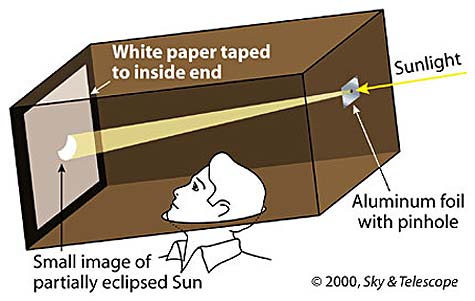 |
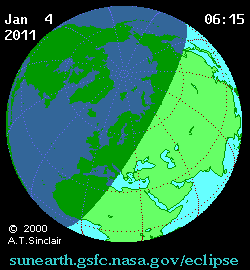 |
At left: the Pinhole Projection Method. The simplest safe way to view a partial solar eclipse is to watch the Sun's image projected onto a piece of paper. Poke a small hole in an index card with a pencil point, face it toward the Sun, and hold a second card three or four feet behind it in its shadow. The hole will project a small image of the Sun's disk onto the lower card. This image will go through all the phases of the eclipse, just as the real Sun does. Experiment with different size holes. A large hole makes the image bright but fuzzy; a small hole makes it dim but sharp.
|
| |
|
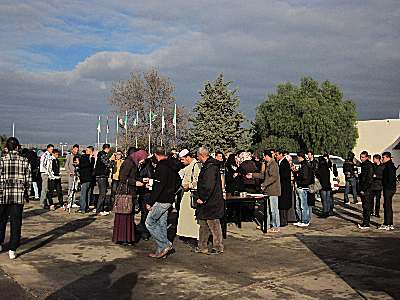
The spectacle ended on time before a cloud layer moved towards the Eastern horizon. |
 |
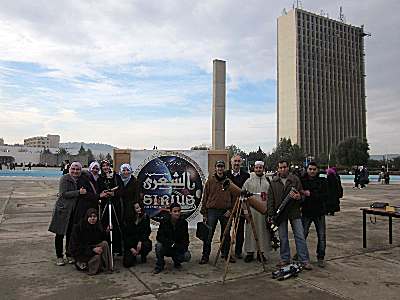
Here's part of the Sirius team who worked with the public during the whole cosmic show.
|
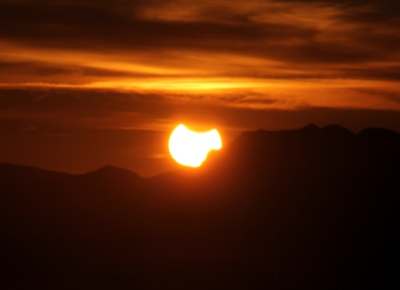 First picture of the solar eclipse in Algeria put on the net by the CDTA (Centre de Développement et de Technologie Avancée) at Bouzaréah. |
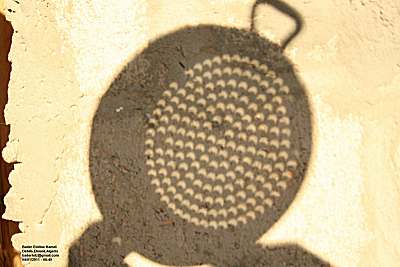
From Debila, El-Oued with love. This picture was taken from Southern Algeria by Baddredine Hamdi, a long time Sirius friend. |
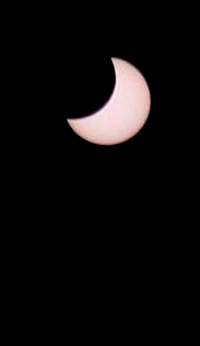 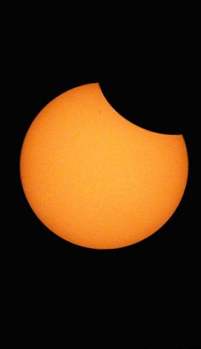
Pictures by B. Hamdi (At left), and Osama Al-Busaidi (at right) from the Omani Astronomy Association in Sultanate of Oman. |
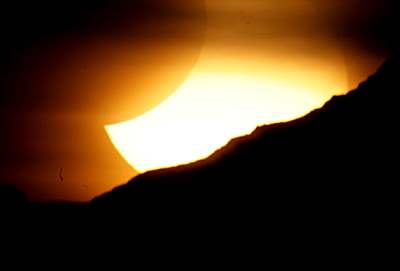 |
 |
Our brothers from AAA in Marrakech in Morocco sent us the whole sequence they captured, from sunrise to the exit. |
The "Adab" of Watching an Eclipse in Islam
Partial Solar Eclipse 04-Jan-2011, God-willing
By Usama Hasan,
from his site
For London, the eclipse will begin around 7am, and thus only be visible from sunrise, around 8.12am, and end around 9.31am.
DO NOT LOOK DIRECTLY AT THE SUN AT ANY TIME, WHETHER DURING AN ECLIPSE OR NOT, ELSE YOU RISK SERIOUS DAMAGE TO YOUR EYESIGHT, AND PERHAPS EVEN BLINDNESS.
The only exception to this is for the few minutes during a total solar eclipse when the moon totally obscures the sun. Since this is a partial eclipse, that does not apply. The fact that we depend on the sun for all our light, warmth and energy needs and daily routine, yet go throughout life without ever looking at it, is a metaphor for the fact that we cannot see God in this world, being veiled from Him, although His creation and knowledge is everywhere around us. We only get to see God in the next life, for those who deserve the Beatific Vision.
Eclipse sighting in the Islamic Tradition
In the Islamic tradition, a solar eclipse, like any wonderful natural phenomena, is a Sign of God and therefore a good time for reflection, prayer, meditation and charity, etc. Those who wish to observe the Islamic solar eclipse prayer at this time may wish to note the following:
1. The prayer is normally done when the eclipse is visible: in this case, from sunrise. However, extra prayer is usually forbidden for the 5-10 minutes before and after sunrise to avoid imitating sun-worshippers. My view is that it’s best to wait about 10 minutes after sunrise before offering the eclipse prayer.
2. It would be acceptable to offer or start an eclipse prayer an hour or so before sunrise, since the astronomical calculations are precise to within a minute or two, and hence one knows that the eclipse is taking place. This would be similar to following Imam Subki’s fatwa that someone who knows astronomically that a visible crescent moon is present behind the clouds is permitted to observe lunar months on that basis, including Ramadan. However, extra prayer is usually discouraged or forbidden after the dawn prayer and before sunrise, but in this case it would be acceptable as a special exception. One could therefore, of course, begin the eclipse prayer before sunrise, continuing during sunrise and concluding afterwards. Would that be acceptable? The jurists may discuss it endlessly. My view is that it would be acceptable, since it is not imitating sun-worshippers, like someone who begins the Dawn Prayer shortly before sunrise and concludes it afterwards.
3. The solar eclipse prayer consists of two rak’ahs (cycles). In the Sunni tradition, three of the main schools have an extra ruku’ (bowing) in each cycle, making a total of two bowings and two prostrations in each cycle. Before each bowing, the Qur’an is recited, with the jurists disagreeing over whether or not The Opening Chapter (Surah al-Fatihah) must be recited in each section, or simply once per rak’ah. The Hanafi school holds that there are no extra bowings, so that it is a normal two-rak’ah prayer. The other three schools accept this also as a valid form of the prayer. All of these possibilities are valid forms of the prayer.
4. The Prophetic way was to observe a very long eclipse prayer, lasting the entire duration of the event, i.e. 2-3 hours. This is not necessary, but recommended. The minimum is a normal two-rak’ah prayer, as detailed above.
5. The prayer may be performed individually, or in congregation. Congregation is better. The jurists differ as to whether the recitation of the individual or the imam (leader of the congregation) should be aloud or quiet. God-willing, all methods are acceptable. Some jurists held that a lunar eclipse prayer has loud recitation whilst the solar eclipse prayer has quiet recitation since these are performed by night and day respectively, analogous to the loud recitation for the daily night and dawn (darkness) prayers and the quiet recitation in the daily afternoon prayers. For a long, congregational prayer, loud recitation may be best in both cases. When I helped to revive the Sunnah of the solar eclipse prayer at Masjid Tawhid during August 1999 by spreading awareness and leading several hundred worshippers in a two-rak’ah prayer for over an hour, I recited loudly from the long mufassal surahs (roughly, parts 27-29) of the Qur’an.
The eclipse should be an awe-inspiring event, as usual, if we are blessed with clear skies. Even if it is overcast or cloudy, we may be able to detect less sunlight than usual. May we be showered with God’s blessings, internally and externally, during the eclipse and forever afterwards!
|
|
.gif)
|

